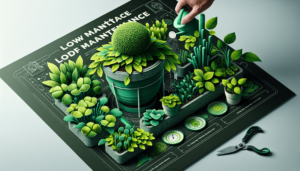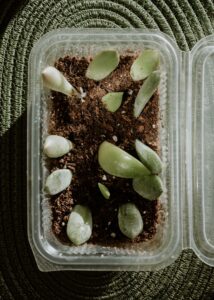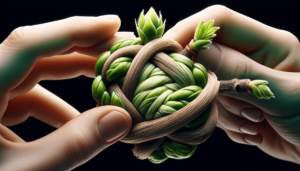Have you ever wondered how plants are propagated without using seeds or cuttings? Look no further! This article unveils the fascinating world of air layering, a technique that allows us to grow new plants from existing ones. Whether you’re a seasoned gardener or just starting, join us as we explore the secrets behind this unique propagation method.
What is Air Layering
Definition of air layering
Air layering is a propagation technique used to grow new plants from existing ones by encouraging the growth of roots on a stem or branch while it is still attached to the parent plant. This method involves making a small incision into the stem or branch, applying rooting hormone, and then wrapping it in a moist medium to encourage the development of roots. Once the roots have formed, the branch can be cut and planted as a new, independent plant.
Advantages of air layering
Air layering has several advantages over other propagation methods. First, it allows us to produce identical clones of the parent plant, ensuring that the new plant will have the same desirable characteristics. This is particularly useful when propagating plants with unique traits or fruits. Air layering generally results in faster root development than other methods, such as seed germination or cuttings. This means the new plant will establish itself more quickly and can be transplanted sooner. Furthermore, air layering is a suitable technique for propagating complex plants to root using other methods, making it a valuable tool for plant enthusiasts.
Disadvantages of air layering
While air layering can be an effective propagation technique, it has some disadvantages. One of the main drawbacks is that it requires more time and effort compared to other methods. Air layering involves several steps and requires monitoring the roots’ progress over time. Another disadvantage is that it may not be suitable for all types of plants. Some plants do not respond well to air layering; other propagation methods may be more appropriate. Additionally, air layering may not be practical for large-scale propagation projects due to the time and labor involved.
When to Use Air Layering
Plants suitable for air layering
Air layering is a versatile technique that can be used on various plants. However, it is most commonly used on woody plants such as fruit trees, shrubs, and ornamental trees. Some popular choices for air layering include citrus trees, roses, camellias, and magnolias. These plants often have valuable traits or produce desirable fruits, making them ideal candidates for propagation through air layering.
Best season for air layering
The best time to perform air layering largely depends on the plant species. Generally, the ideal air layering season is during the spring or early summer when the plant is actively growing. This is when the tissues are most pliable and have a higher success rate in producing roots. It is essential to avoid air layering during extreme weather conditions, such as hot summers or freezing winters, as these conditions can negatively affect root development.
Conditions for successful air layering
Certain conditions need to be met for air layering to be successful. The first and most important condition is selecting a healthy and vigorous branch. The branch should ideally have a diameter of at least half an inch, as smaller branches may not develop sufficient roots. Additionally, the branch should be free from diseases or pests that could hinder the root development process.
Another critical factor is moisture. The medium wrapping of the air layer should be consistently moist to promote root growth. This can be achieved by regularly watering or misting the medium or using moisture-retaining materials such as sphagnum moss. Finally, providing the air layer with appropriate environmental conditions, such as sufficient sunlight and temperature, will significantly improve the chances of success.
Air Layering Step-by-Step
Selecting a suitable branch
The first step in air layering is selecting a suitable branch. Look for a healthy branch on the parent plant at least half an inch in diameter. Avoid too small or weak branches, as they may not produce enough roots to sustain the new plant.
Preparing the branch
Once a suitable branch has been selected, remove any leaves or side shoots along a 6 to 12-inch section where the air layer will be created. This will help redirect the plant’s energy towards root development rather than leaf growth.
Making the incision
Using a sharp knife or pruning shears, make an upward or slanting cut into the branch. The cut should be about 1/3 of the way through the branch, creating a small notch. This will facilitate the rooting process by exposing the inner tissues of the branch.
Applying rooting hormone
After making the incision, apply a small amount of rooting hormone to the exposed area. Rooting hormones contain plant hormones that stimulate root growth and increase the chances of successful air layering. Be sure to follow the instructions on the product for the appropriate amount to use.
Wrapping the branch
Next, wrap a moist medium such as sphagnum or peat moss around the incision site. The medium should be firmly packed around the cut, ensuring it stays in place during the rooting process. Plastic wrap or a plastic bag can hold the moss in place.
Securing the air layer
To secure the air layer, tie the plastic wrap or bag tightly around the branch using twist ties or string. This will prevent moisture loss and keep the medium in contact with the branch, encouraging root development.
Providing moisture
Once the air layer is secured, providing moisture to promote root growth is crucial. Check the medium regularly and ensure it remains consistently moist. Water or mist the medium as needed to keep it from drying out.
Checking for root development
After a few weeks or months, depending on the plant species, check the air layer for root development. Carefully unwrap the plastic and gently peel back the moss to inspect for the presence of new roots. If roots have formed and are at least an inch long, the air layer is ready for separation from the parent plant.
Cutting and planting the air layer
Once root development has occurred, carefully cut the air layer below the root zone using sharp pruning shears. Trim away any excess moss and plant the air layer in a pot filled with potting soil or rooting mix. Keep the newly planted air layer in a sheltered area and continue to provide appropriate care until it is established.
Materials Needed for Air Layering
Pruning shears
Sharp pruning shears are essential for making clean and precise cuts during air layering. Dull or unsuitable tools can crush or damage the branch, resulting in lower success rates.
Rooting hormone
Rooting hormone is a powdery substance containing plant hormones, such as auxins, which stimulate root growth. Using rooting hormone increases the chances of successful root development and, ultimately, the establishment of a new plant.
Plastic wrap
Plastic wrap or a plastic bag wraps the air layer and holds the moist medium in place. It helps maintain the required moisture levels and creates a favorable environment for root development.
Twist ties or string.
Twist ties or strings secure the plastic wrap around the air layer. It is essential to secure the wrap tightly to prevent moisture loss and ensure good contact between the branch and the moist medium.
Moisture-retaining medium
A moisture-retaining medium is necessary to provide the optimal environment for root growth. Sphagnum moss, peat moss, or a mixture of these materials can be used as the medium for wrapping the air layer.
Potting soil or rooting mix
After the air layer has roots, it must be planted in a suitable growing medium. Potting soil or a rooting mix that provides good drainage and nutrient availability is recommended for this purpose.
Tips for Successful Air Layering
Choosing the right branch
Selecting a healthy and vigorous branch at least half an inch in diameter is crucial for successful air layering. Weak or diseased branches may not produce sufficient roots to support the new plant.
Using the correct size of the air layer
The size of the air layer should be around 6 to 12 inches in length, encompassing the stem or branch where rooting is desired. This provides enough space for root development without overwhelming the parent plant.
Making a clean and straight cut
When making the incision into the branch, using a sharp knife or pruning shears is essential to ensure a clean and straight cut. A clean cut promotes faster healing and better rooting.
Applying the right amount of rooting hormone
The amount of rooting hormone to apply depends on the specific product and plant species. Follow the instructions on the rooting hormone package to determine the correct dosage. Applying too little rooting hormone may reduce the chances of successful root development, while using too much can harm the plant.
Securing the air layer properly
Properly securing the air layer is essential to maintain contact between the branch and the moist medium. Tying the plastic wrap or bag tightly around the air layer prevents moisture loss and ensures consistent root development.
Monitoring moisture levels
Consistently moist conditions are vital for successful root development. Regularly check the medium and mist or water it as needed to prevent it from drying out. Balancing moisture levels is crucial, as excessive moisture can lead to rot.
Providing appropriate environmental conditions
Ensuring the air layer is exposed to adequate sunlight and temperature conditions is crucial for successful air layering. Most plants prefer a bright, indirect light environment. Avoid exposing the air layer to extreme temperatures, which can hinder root development.
Common Mistakes to Avoid
Using a weak or unsuitable branch
Attempting air layering on a weak or diseased branch is unlikely to yield successful results. To ensure a higher success rate, choose a healthy and vigorous branch with a diameter of at least half an inch.
Making a sloppy or incorrect cut
A clean and straight cut is essential for the air layering process. Sloppy or incorrect cuts can result in less successful root development. Take the time to make a precise cut to maximize the chances of success.
Applying too much or too little rooting hormone
Using too much or too little rooting hormone can negatively affect root development. Follow the instructions with the rooting hormone product to ensure the correct amount is applied for optimal results.
Failing to secure the air layer properly
Properly securing the air layer is crucial to maintaining contact between the branch and the moist medium. Failing to ensure the air layer tightly can lead to moisture loss and reduced root development.
Neglecting to monitor moisture levels
Consistently moist conditions are crucial for successful root development. Neglecting to monitor the moisture levels of the medium can lead to dry conditions, hindering root growth. Regularly check the medium and adjust the moisture levels as necessary.
Exposing the air layer to harsh environmental conditions
Extreme temperatures or harsh environmental conditions can negatively impact root development. It is essential to provide the air layer with appropriate environmental conditions, including adequate sunlight and temperature, to maximize the chances of success.
Alternative Air Layering Methods
Serpentine air layering
Serpentine air layering is a method that involves making multiple incisions along a long section of the branch rather than a single cut. Creating a series of notches stimulates more root development sites along the branch, increasing the chances of successful air layering.
Ring or wrap air layering
Ring or wrap air layering is a technique in which a section of bark is removed from the branch, creating a ring-shaped cut. A moist medium is then wrapped around the bare area, encouraging root growth. This method is beneficial for plants with thick bark.
Tongue air layering
Tongue air layering is a method that involves making two parallel cuts into the branch, similar to V-shaped incisions. The raised bark between the cuts is removed, leaving a small notch or tongue. The notch is then treated with rooting hormone and wrapped with a moist medium to stimulate root development.
Benefits of Air Layering
Produces identical clones
One significant benefit of air layering is that it produces identical clones of the parent plant. This ensures that the new plant will have the same traits, characteristics, and fruit as the parent plant. This can be especially valuable when propagating specific varieties or plants with desirable traits.
Faster root development
Compared to other propagation methods, such as seed germination or cuttings, air layering often results in faster root development. This means the new plant will establish itself more quickly and can be transplanted sooner. This can be particularly advantageous when time is of the essence or when plant propagation needs to be accelerated.
Allows propagation of difficult-to-root plants
Some plants, especially woody species, are notoriously difficult to root using traditional propagation methods. Air layering provides a solution by directly creating the optimal conditions for root development on the parent plant. This makes it possible to propagate plants that would otherwise be challenging or impossible to reproduce using other methods.
It can be done indoors or outdoors.
Air layering can be performed indoors and outdoors, making it a versatile propagation technique. Indoor air layering allows for year-round propagation and can be particularly convenient for individuals with limited outdoor space. Outdoor air layering takes advantage of natural environmental conditions, mainly during the growing season, enhancing the chances of success.
Uses of Air Layering
Propagating fruit trees
Air layering is commonly used to propagate fruit trees. This method allows growers to produce genetically identical clones of their desired fruit trees, ensuring consistent quality and characteristics. Air layering is particularly effective for fruit tree species that are difficult to propagate through other methods, such as cuttings or grafting.
Creating bonsai trees
Bonsai enthusiasts often utilize air layering techniques to create miniature versions of their desired tree species. By air layering a branch from a mature tree, growers can obtain a new plant with established roots suited for bonsai cultivation. Air layering allows for precise control over the height and proportions of the bonsai tree.
Renewing and rejuvenating older plants
Air layering can also rejuvenate older plants that have become leggy or unattractive. By air layering a selected branch, new plants can be propagated to grow and develop more vigorously than the older plant. This is particularly useful for ornamental trees and shrubs that may have lost their vitality over time.
Conclusion
Air layering is a valuable technique for propagating plants. It allows us to create identical clones of desired varieties or propagate plants that are difficult to root through other methods. Air layering can be a successful and rewarding propagation technique that follows a step-by-step process and uses appropriate materials. Whether it is used for propagating fruit trees, creating bonsai trees, or renewing older plants, air layering offers a versatile and effective way to expand our plant collection and enjoy the benefits of plant propagation.



